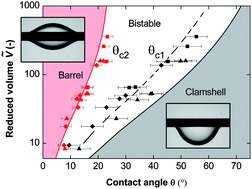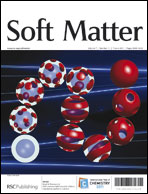Drops on functional fibers: from barrels to clamshells and back†
Abstract
Drops on cylindrical fibers are a familiar sight, for instance in the form of dew drops on spider webs. They can exist in two competing morphologies, a cylindrically symmetric barrel state completely engulfing the fiber and an asymmetric clamshell state, in which the drop touches the fiber only sideways. Despite their omnipresence and their practical relevance, e.g. for the adherence of drops to fibers in separation technology and filter materials, the physical mechanisms governing the stability of the two morphologies remained elusive. Using electrowetting-functionalized fibers we can tune the wettability of the fibers and thereby reversibly switch between the two states. This allows determination of the stability limits of both morphologies as a function of the two relevant control parameters, namely the contact angle and the liquid volume. While clamshells are found to prevail for large contact angles and small volumes, and barrels prevail for small angles and large volumes, there is also a wide range of intermediate parameter values, for which both morphologies are mechanically stable. Mapping out the energy landscape of the system by numerical minimization of the free energy we find that the barrel state is easily deformed by non-axisymmetric perturbations. Such perturbations facilitate the transition to the clamshell state and thereby the removal of drops from the fibers. From a general perspective, the demonstration of electrowetting-based reversible switching of liquid morphologies on fibers opens up opportunities for designing functional textiles and porous materials for various applications in detergency, filtering, and controlled absorption and release of liquids.


 Please wait while we load your content...
Please wait while we load your content...